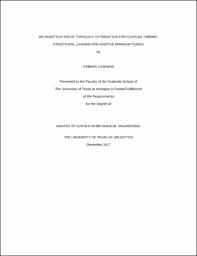
ATTENTION: The works hosted here are being migrated to a new repository that will consolidate resources, improve discoverability, and better show UTA's research impact on the global community. We will update authors as the migration progresses. Please see MavMatrix for more information.
Show simple item record
| dc.contributor.advisor | Taylor, Robert M. | |
| dc.creator | Gaikwad, Vaibhav Shankar | |
| dc.date.accessioned | 2020-04-08T15:52:10Z | |
| dc.date.available | 2020-04-08T15:52:10Z | |
| dc.date.created | 2017-12 | |
| dc.date.issued | 2018-01-12 | |
| dc.date.submitted | December 2017 | |
| dc.identifier.uri | http://hdl.handle.net/10106/29047 | |
| dc.description.abstract | This work investigates the ability of topology optimization methods to design multifunctional components with coupled thermo-structural loading for fabrication with additive manufacturing technologies. Topology Optimization is a mathematical approach developed to perform design optimization with the purpose of reducing material usage, while maximizing the structural and thermal performance, in accordance to specific design constraints. Additive manufacturing provides the capability to create internal structures and complex surfaces developed by topology optimization that would not be possible to produce by conventional manufacturing. The more structurally efficient configuration generated by topology optimization and fabricated with additive manufacturing can result in components with improved structural capability and reduced mass. Design optimization most often follows a single discipline approach in which analysis is carried out either by solving the problem from a structural or a thermal point view, but not both simultaneously. The present work involves the study of combined thermal and structural systems using a multidisciplinary optimization technique to design co-optimal systems.
The investigation for this work consists of two case studies: the design of a structural heat conductor and the design of an exhaust-washed structure. For a simple structural heat conductor with various thermal and structural boundary conditions, minimizing compliance is a structural objective whereas minimizing the maximum temperature is a thermal objective, hence carrying out structural analysis on a thermally optimized beam and vice versa. The presence of a thermal load may influence the structural performance by affecting component behavior and vice-versa for structural loading. To overcome this problem, combining both thermal and structural analysis is important. Thus, a systematic
5
study of obtaining a thermal objective using structural constraint and structural objective using a thermal constraint is carried out for the combined system to be co-optimal. Also, the design of aircraft exhaust washed structure has been carried out using a minimum compliance objective. | |
| dc.format.mimetype | application/pdf | |
| dc.subject | Topology optimization | |
| dc.title | AN INVESTIGATION OF TOPOLOGY OPTIMIZATION FOR COUPLED THERMO-STRUCTURAL LOADING FOR ADDITIVE MANUFACTURING | |
| dc.type | Thesis | |
| dc.degree.department | Mechanical and Aerospace Engineering | |
| dc.degree.name | Master of Science in Mechanical Engineering | |
| dc.date.updated | 2020-04-08T15:52:11Z | |
| thesis.degree.department | Mechanical and Aerospace Engineering | |
| thesis.degree.grantor | The University of Texas at Arlington | |
| thesis.degree.level | Masters | |
| thesis.degree.name | Master of Science in Mechanical Engineering | |
| dc.type.material | text | |
Files in this item
- Name:
- GAIKWAD-THESIS-2017.pdf
- Size:
- 5.287Mb
- Format:
- PDF
This item appears in the following Collection(s)
Show simple item record


